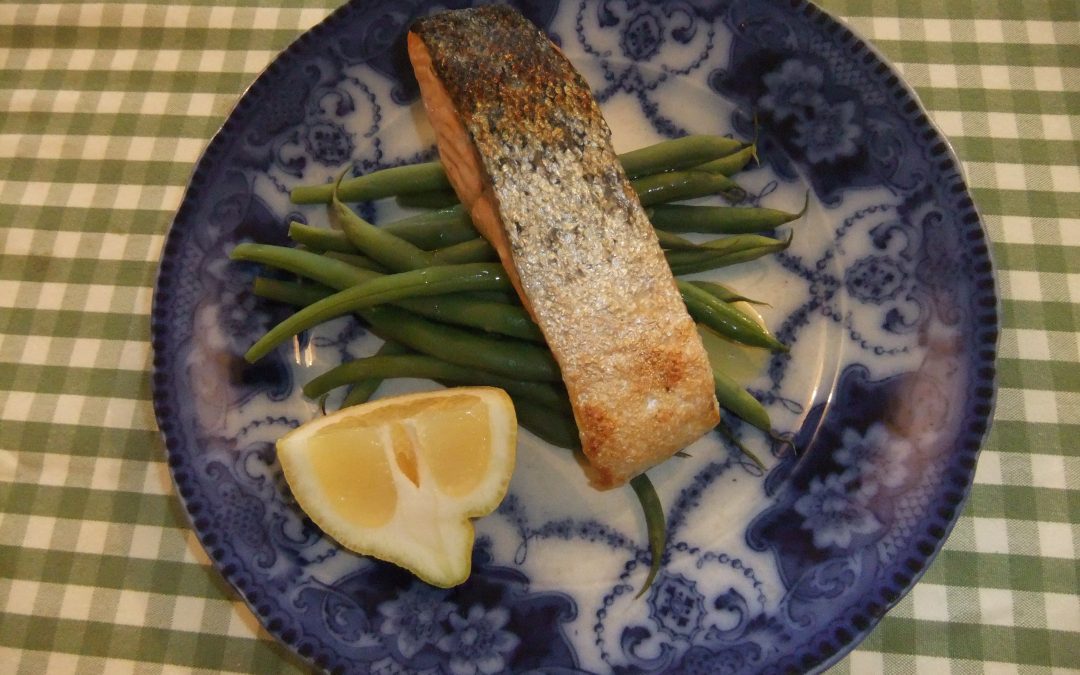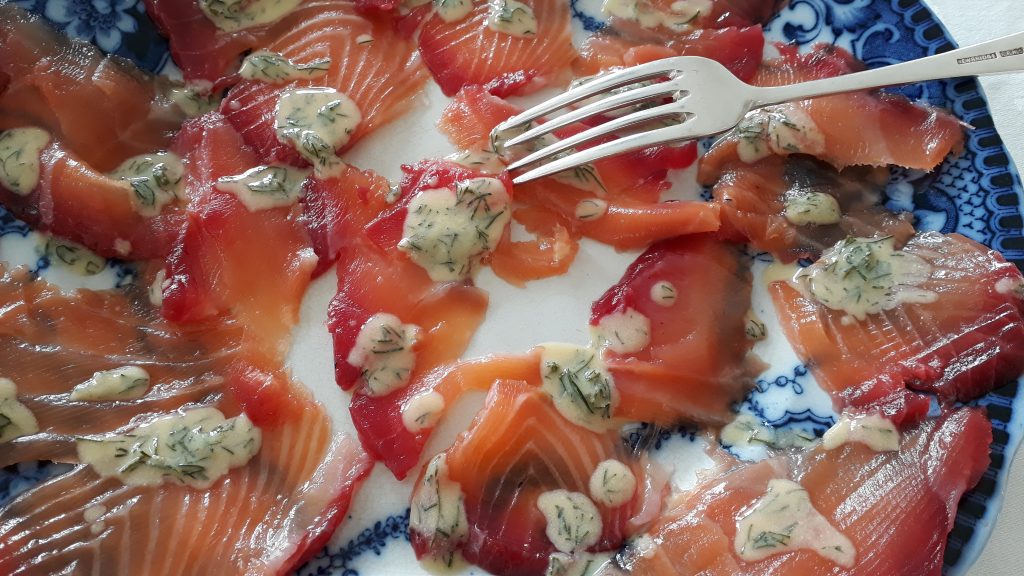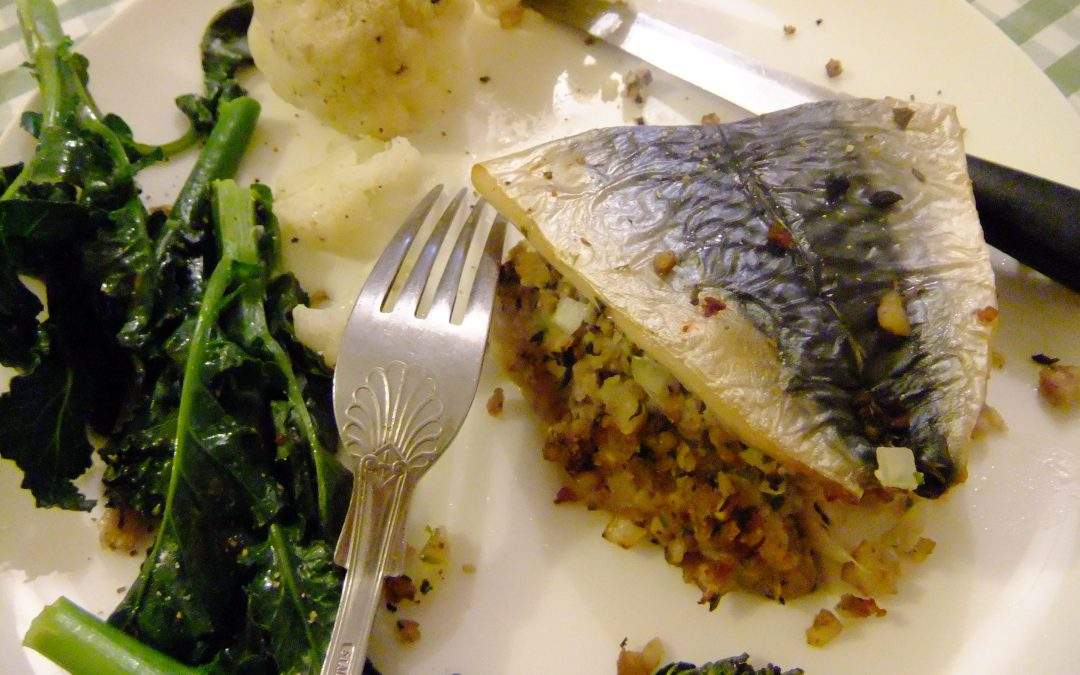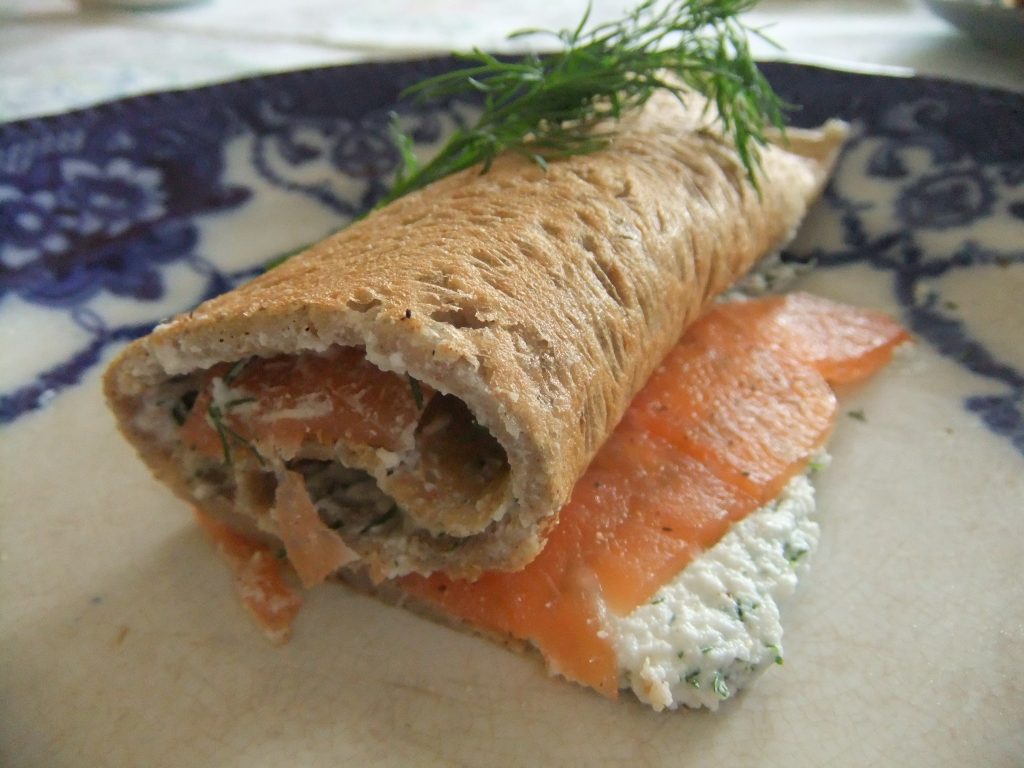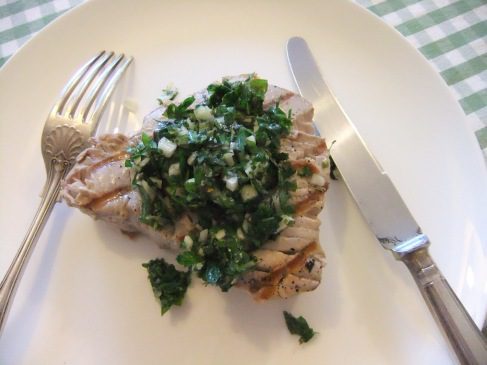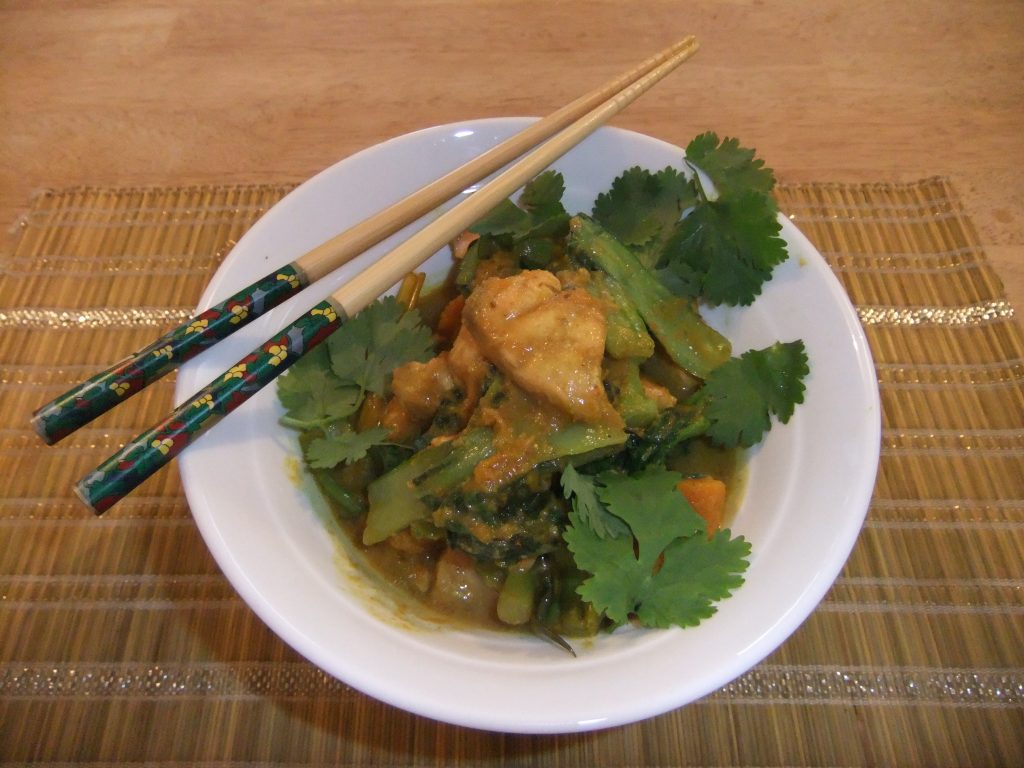
Apr 23, 2019 | Anna's Best Recipes, Main courses
This recipe is super-easy. It’s what I make when I come home late and want dinner on the table in 15-20 minutes.
For 2
2 salmon darnes/fillets/steaks, ideally wild or organic
A large clove of garlic, peeled and crushed
Tamari Sauce (see “larder & shopping” for where to buy)
1. Brush fish on both sides with the sauce, smear with the garlic.
2. Grill on medium heat for around 5 minutes flesh side up and 1-2 minutes skin side up until very slightly browned (watch it when grilling the skin side, it goes from not done to burnt very quickly).
Serve with:
- Steamed green or runner beans drizzled with fresh lemon juice or a large salad of mixed leaves, cherry tomatoes and sliced red onion drizzled with my home-made mediterranean or Asian salad dressing or a little fresh lemon juice and a glug of extra virgin olive oil. These accompaniments are suitable for a paleo (stoneage) or ketogenic eating diet.
- If you don’t want to lose any weight you could also add a medium steamed or baked sweet potato (just scrub, slice and steam with the skin on for extra nutrients) or some baby boiled white potatoes. Carbohydrates (grains, potatoes, sweet foods) are weight gainers.
Why this recipe is good for you:
Oily fish is a great source of omega 3 essential fats needed for weight management, beautiful skin and good brain function. Eating fresh rather than tinned fish is best because the plastic lining of tins contains bisphenol A (BPA). Fats in the food absorb BPA. BPA is linked by numerous studies to sex hormone imbalance (eg PMS, low libido, endometriosis, fibroids) and life-threatening diseases of the breast and prostate. Greens are a rich source of magnesium, which helps the liver clear natural and man made toxins from the body. common symptoms of magnesium deficiency include stress, wheezing in asthmatics, and sluggish bowels.

Jan 9, 2019 | Anna's Best Recipes, Main courses

Mustard-baked mackerel
This is is a super simple recipe I concocted today, inspired by a Nigel Slater recipe. Its ideal for a one-person dinner, or for a family. The mustard and lime lift the richness of the oily fish and are amazing for you too.
For 2:
2 fresh mackerel fillets
1 dsp coarse grain mustard
1 dsp fresh lemon or lime juice
Generous pinch black pepper
Pinch Himalayan salt/sea salt
1/2 tsp dried tarragon if you have it
A little olive oil to grease your roasting tin
To serve:
2 cupfuls sliced carrots
4 cupfuls broccoli florets
1. Heat your oven to 200C and while it is heating steam your vegetables and keep warm.
2. In a little bowl mix the mustard, pepper, salt, citrus juice and (if using) tarragon.
3. Oil your roasting tin, lay the fish skin side down, slather with the mustard mix and bake for 12-15 minutes. When the fish is done, it will no longer be translucent and the point of a knife or skewer will go through it easily.
4. Enjoy.
Why this is good for you:
We all know that omega 3 oils from wild mackerel are great for our brains and hearts. But did you know that having enough omega 3 affects every cell in your body – from helping you avoid diabetes (or get rid of it if you have it), to helping your body react efficiently to all your horrnones. Eating more oily fish is a no-brainer. Mackerel is one of the best oily fish as its always wild so its leaner and cleaner. Mustard is a spice and is powerfully antioxidant. It even helps prevent eczema breakouts. If you want a healthy brain and body for many many years to come, get the spices in to your everyday eating. Spices AND herbs (like tarragon) pack a powerful antioxidant punch to lower inflammation and help you age agelessly. And they liven up your plate. What’s not to like!

Dec 19, 2018 | Anna's Best Recipes, Main courses, Sides, starters, soups & snacks
This is a recipe I love. We eat it Christmas day with a simple salad of watercress and lambs lettuce. Instead of doing what the recipe says (wrapping everything in foil while it cures) I use a glass box with plastic lid to keep everything compressed during 5-8 days or curing. Much less fiddly. Lime zest/beetroot are optional but give an amazing taste and a lovely deep pink colour. Before you start, freeze the salmon for at least 24 hours to help kill any parasites. The salt, pepper and dill in the cure and the mustard in the sauce also help kill any unwanted visitors to your tummy!
For the cure:
1 large side of salmon, organic if possible, cut into 2 roughly equal shape pieces
Zest of 1-2 organic limes
1 large bunch fresh dill
115g sea salt/Himalayan salt – flakes or fine it doesn’t matter
50g coconut sugar (use brown sugar if you don’t have coconut)
75g xylitol or erythritol (from health shops)
15g freshly ground black pepper (coarse is OK)
Optional beetroot – 1 raw, grated (cooked might work too)
Tinfoil
For the sauce (to serve with the fish on the day):
1 tbs chopped fresh dill
1 tbs English mustard powder (if you don’t need gluten-free you can use ready-made English mustard from a jar)
1 tsp coconut sugar, erythritol, xylitol or brown sugar
1 tbs virgin (cold pressed unrefined) sunflower/peanut/rape/sesame oil
2 tbs kefir*, creme fraiche (for dairy-free use unsweetened additive-free soya yoghurt)
1 tbs white wine vinegar or apple cider vinegar
*home made fully-fermented kefir is usually tolerated by people with dairy sensitivity
1. For the cure (5-8 days before you want to eat the fish)
Roughly chop the dill and mix thoroughly in a bowl with the zest, salt, sugar, xylitol/sugar, lime zest, optional beetroot and pepper. Lay out a sheet of foil about four times the width of a salmon fillet. Spread a quarter of the pickling mix over a fillet-size area on one side of the foil with a good 15cm/6in margin for folding over.
2. Place one piece of fish, skin side down, on top of the pickle mixture and cover with slightly more than half of what is left. Place the second fillet on top, skin side up, to make a sandwich. Scatter the remaining pickle mixture over the skin. Wrap up the parcel tightly, tucking the ends and edges in underneath the fish.
3. Put the package on the tray and place a similar size tray, or a plank of wood on the top. Weight it down, with a brick or two or anything else handy (the contents of the fridge?). Turn the package daily for at least five days, and no more than eight. Do not discard the pickling liquid that oozes from the package unless it threatens to spill over the side of the tray.
4. At least one hour before you wish to serve the fish, combine all the ingredients for the dressing in a jar and shake well together. Leave to stand and shake again to emulsify before serving.
5. To serve, unwrap the gravalax and wipe off any excess pickling liquid. I like to scrape off the bits of dill and beetroot and give everything a quick wipe but you don’t have to. Slice fairly (but not too) thinly then serve with the sauce and a green side salad (I love watercress and lamb’s lettuce with this). Unused gravalax can be re-wrapped in clean foil or airtight glass box and kept in the fridge for up to five days.

Mar 11, 2015 | Anna's Best Recipes, Breakfasts & smoothies, Main courses
This is a great breakfast (or any meal) and is super fast. The kippers are left to stand in boiling water for a few minutes while you grill the courgettes and tomatoes, simple…
I like to remove the skin of the kipper before cooking because otherwise it causes the fish to curl up unattractively. But if you don’t care about that, don’t bother. You could also have the lovely vegetables more simply with a small smoked mackerel or trout fillet – no need for the pan of water.
1 small kipper (smoked herring) fillet, skin removed with a sharp knife
1 medium courgette, sliced lengthways into strips around ½ cm thick
2 medium tomatoes, halved, woody bit removed
Extra virgin olive oil
1 teaspoons dried oregano
Freshly ground black pepper
1. Boil the kettle. While the kettle is heating up place a small pan on a medium heat to warm before putting in the kipper and pouring on enough boiling water to cover. Take off the heat and leave to poach in the hot water for about 3 minutes.
2. Meanwhile heat the grill. Place the courgettes and tomatoes on a baking sheet or on the grill rack and cook until just softened. You are not looking for everything to be squishy, just heated through and softened slightly.
3. Arrange on a plate, sprinkle with olive oil to taste and scatter the dried oregano over the tomatoes.
4. Serve with the kipper.
Why this is good for you:
Kippers are smoked herrings. Because herrings are a wild cold water fish, they are rich in essential omega 3 fats you need for healthy skin and hair. Omega 3 helps prevent your blood from clotting too much and this helps bring more blood and nutrients to the whole of your body. Oregano, even dried, is high in antioxidants (provided you store it away from light and air) and has anti-fungal, anti-yeast and anti-microbial properties against bad bacteria in your gut. “Bad” bacteria and yeast are a major cause of skin problems and weight issues. They can be lowered, and good bacteria encouraged, by what you eat every day. Tomatoes and courgettes are a rich source of beneficial fibre and (more) antioxidants, which protect our bodies from inflammation and delay the ageing process. This breakfast is very light on carbohydrates (sugars) and free from grains so its super-healthy.

Nov 27, 2013 | Anna's Best Recipes, Main courses
I took a notion with some leftover stuffing last week and made this and it was lovely, moist and rich. It brought me right back to sister Carmel’s home economics class in my convent school many years ago. Only she used breadcrumb stuffing instead of gluten-free chestnut stuffing. If you want, you can make the stuffing (posted last week) using gluten-free brown breadcrumbs instead of the chestnut. It works just as well provided you add enough oil or butter to moisten the crumbs so they will stick together when pressed with your hand.
For 2
1 1/2 -2 cups of my chestnut stuffing (you don’t have to be exact here)
2 fresh mackerel fillets
I roasting tin, pyrex dish or baking sheet
A little oil to grease
- Preheat the oven to 200C and grease the tin (just the merest hint of oil to prevent the fish sticking).
- Cut the mackerel fillets in half across the fish (not lengthways).
- Lay one half of each fillet skin side down in the tin, top with half the stuffing. Lay the second half on top of each, skin side up this time.
- Bake for 15-20 minutes, depending on the size of your fillets. When done, the point of a skewer or sharp knife will slip easily through the flesh once you have pierced the skin. You want the fish still moist and juicy and not dried out.
Serve with:
Steamed green vegetables and carrots topped with a knob of virgin coconut oil, a drizzle of lemon juice or a glug of extra virgin olive oil.
Why this recipe is good for you:
Mackerel is a great source of vitality-boosting omega 3 oils and baking it rather than frying preserves the omega 3 benefits. Herbs and spices are a powerhouse of anti-inflammatory substances that promote health. Hundreds of thousands of high quality research papers now show that herbs have powerful effects for good on your health – from delaying aging, to helping heal an inflamed digestive system, to even helping your liver cope with too much rich food (and drink). Chestnuts are low GI (low in natural sugars), making them a healthier option than breadcrumbs.

Aug 23, 2013 | Anna's Best Recipes, Breads, crackers, pancakes & wraps, Breakfasts & smoothies, Main courses
Ate these last Sunday for a late and leisurely breakfast. If you have ever successfully made ordinary pancakes, these will be a doddle for you. Buckwheat galettes are a traditional pancake made in Brittany and eaten with savory fillings. They are naturally gluten-free. If you want, you can store them in the fridge for 1 day, or freeze them for up to one month. When freezing, separate them with greaseproof or baking paper and store them in a self-seal bag to prevent drying out. To serve made-in-advance galettes hot, add one at a time to a dry frying pan, when the first side is hot, flip over. This recipe makes 4 large galettes. to make this a balanced lunch or dinner, simply add a large salad or steamed green vegetables drizzled with olive oil.
Buckwheat pancake with ricotta, dill & smoked salmon
For 2 piggy eaters (or 4 normal appetites!)
100g buckwheat flour (for unusual ingredients see larder section)
1 large egg, organic if possible
300ml/ ½ pint liquid – use 150ml/ ¼ pint each water and milk (rice milk, cows milk or soya milk or oat milk – NB oat milk may contain gluten) or use all water. See larder for further info.
A little virgin macadamia oil, coconut oil, or, if you can’t get these, some extra virgin olive oil
Freshly ground black pepper
100g smoked salmon, ideally wild or organic
1 small tub (150-200gg) buffalo or cow ricotta cheese (if you can’t get this, use low-fat cottage cheese, mashed or blitzed in a processor until smooth-ish in texture)
2 tbs chopped dill herb (a small bunch should be enough to yield this quantity)
1. Sift the flour into a large bowl.
2. Make a well in the middle and break in the egg and add a few grinds of black pepper.
3. Using a whisk, gradually add the liquid, whisking well, until the mix has the consistency of thin cream. Depending on the size of the egg, you may need a little more or less fluid than the quantity specified. Like all grain-based foods, buckwheat becomes more digestible if you leave it overnight to soak before cooking.
4. Heat a flat-based frying pan or griddle until hot, wiping a little oil over it with kitchen paper while it is still quite cool (macadamia oil, coconut oil, or extra virgin olive oil are fine)
5. When hot, pour a quarter of the mixture into the centre of the pan, tilting the pan to spread the mixture. Cook for a minute or two, until the pancake, begins to bubble around the edge. Flip it over with a spatula and continue cooking for another minute or two.
6. When the galette is cooked, turn it on to a plate, keep warm in the oven (covered with another plate to keep it all moist) and continue making more and piling them up.
9. To serve, mix the ricotta in a bowl with 2 tbs chopped fresh dill. Cut the salmon into strips and layout on a plate. Give each person a galette and allow them to add the cheese and fish and roll or fold before eating. Yum!
Variations:
Heat up some leftover chickpea curry, bean-based vegetarian curry, chili, or a casserole to use as a filling for these galettes.
Why this is good for you:
Buckwheat flour is a grain that is naturally gluten-free and is packed with nutrition. It is a valuable source of rutin, a bioflavonoid with anti-inflammatory and immune-balancing properties. Rutin, like many other bioflavonoids, helps support the integrity of your skin, making it stronger and less prone to allergic reactions. Ricotta is a cheese made from the watery whey skimmed off after making cheese. Because it is low in casein (the main milk protein that people can be intolerant to), its less likely to be a problem for those with a mild dairy intolerance. Smoked salmon is a high-quality protein that’s packed with essential omega 3 fats. The high protein content of this meal will keep you fuller longer.

Jul 16, 2013 | Anna's Best Recipes, Main courses
This is inspired by a very simple treatment of a steak that I once ate in sunny Amalfi. It was so fresh and zingy I loved it and tried to recreate the taste when I got home. We also use the gorgeous herb-and-garlic topping for a venison steak or a piece of lean sirloin, simply done on a barely-oiled pan. The herbs you use in addition to the parsley depend on what’s convenient for you to buy or pick from your garden.
For 2:
2 tuna steaks, about 120g each (about the size of your palm)
1 small handful of parsley (flat-leaf is nice if you can get it)
A sprig (about 8-10cm long) of rosemary, 3-4 sprigs of thyme, or a handful of oregano sprigs (or all 3 if you are lucky enough to grow your own herbs and have a plentiful supply)
2-3 cloves garlic
Extra virgin olive oil
Freshly ground black pepper
A pinch of Himalayan or Atlantic Sea Salt
To serve: a large mixed salad, with dressing, or 350g steamed French or runner beans
- First of all, wash and dry your herbs and destalk them. you will want, in total about 3 tablespoons of chopped herbs. Then chop as finely as you can manage. The finer the herbs, the less chewy the topping will be. Peel and chop the garlic cloves as finely as you can manage. Add the chopped herbs and garlic to a bowl, season with a few good grinds of black pepper, a pinch of salt, and enough extra virgin olive oil to wet the whole thing so it sticks together a bit. Mix and set aside.
- Prepare your salad or put your beans on to steam before cooking the tuna steaks.
- Heat a heavy-bottomed frying pan or griddle pan. Oil it lightly using some macadamia or olive oil, just enough to get a non-stick film on the pan but not enough to see an oil slick.
- On medium heat, cook the steaks for around 4-5 minutes on each side (it depends on the thickness of the steak). It’s ok to leave fresh tuna a little pink in the middle and it’s moister and more delicious that way.
- Once the steaks are done, slide onto warm plates and pile the garlic-herb mix on top of each one.
- Serve with the salad or steamed French or runner beans.
Dietary note:
Fresh (not tinned) tuna is a great source of omega 3 oils. Garlic and herbs contain potent antioxidants which also enhance many functions in the body, from dampening down inflammation and allergies to boosting liver function. Regularly eating fresh herbs, garlic and oily fish has positive effects on mood, skin health, and digestive wellness. The raw extra virgin olive oil used here is a source of vitamin E which is also anti-inflammatory and anti-ageing. People adding olive oil, raw nuts, and raw seeds to their diet lose weight, according to scientific research.

Jul 15, 2013 | Anna's Best Recipes, Main courses
We love this warming, comforting curry when the weather is grey and cold and guests always seem to love it. My husband adapted it from a recipe by Nigella to have a thicker sauce, more greens, and less starchy carbs that lead to weight gain. If you don’t like any trace of hot spices, this dish is not for you – if you like only moderate heat use just 1 tbsp Amoy or Sharwood’s curry pastes instead of the genuine (and hotter) Thai brands from Asian shops. The more unusual ingredients are all available from good supermarkets, delis, or inexpensively from Asian shops. Leftovers are safe to eat the next day if stored in the bottom (coldest shelf) of the fridge and properly reheated.
For 2:
250g pumpkin or butternut squash, peeled and cut into large bite-sized cubes
165ml tin coconut milk
165 ml fish stock, water leftover after steaming veg, or just plain water
1-2 rounded tablespoons yellow (or red) Thai curry paste
3 tbsp Asian fish sauce
3 fresh lemongrass stalks, each cut into 3 and bashed with a pestle or bruised with the back of a knife
3 lime leaves (frozen or dried), cut into narrow strips if you can be bothered
1 level teaspoon ground turmeric
Handful of fresh coriander, rinsed and roughly chopped (stalks and all is fine)
300g salmon darnes, ideally wild or organic, skinned and cut into bite-size cubes of about 2-2.5cm
A handful of shelled king prawn tails (optional)
350g (2 very large handfuls) of one of the following:
pak choi cut into 2” lengths
streamed-but-still-crisp broccoli florets or green beans
Juice of ½ -1 lime, to taste
Brown basmati rice to serve (see below for cooking instructions)
1. Pour the 165 ml tin of coconut milk, 165 ml of fish stock or water, and 1-2 tbsp of the curry paste into a heavy-bottomed saucepan. Whisk well with a fork to amalgamate, and add the fish sauce, lemongrass, lime leaves, and turmeric. Stir and bring to a boil, then add the butternut squash/pumpkin pieces. Cook on a fast simmer until the pumpkin is tender but not mushy, about 15 minutes, although different sorts of pumpkins can vary enormously in the amount of time they take to cook; some squash can take as little as 5 minutes.
2. To the robustly simmering pan, add the pak choi if using, tamping down with a spoon. Cover and cook until slightly wilted. Then add the salmon and, if using, the prawns. If you are using pre-steamed broccoli or green beans instead of pak choi, add these now. When the salmon is cooked and the pak choi (if using) is wilted, squeeze in the juice of ½ the lime, adding the juice of the remaining half if you feel it needs it.
Serve with:
1/2 mug of brown basmati rice (for 2 people), boiled in a covered saucepan with 1 mug of boiling water and ½ level teaspoon ground turmeric. Do not stir rice when it is cooking. When it’s done you should see that the rice has swelled up, absorbed all the water, and has little steam holes visible in its surface. It should stay warm in a covered saucepan for 10-15 minutes after cooking and fluff up nicely.
Variations:
Make this with 150g raw shelled prawns (frozen is fine, provided the prawns are separated from each other) and 150g salmon instead of all salmon.
Dietary note:
Coconut milk is a rich source of medium chain triglycerides which are a great source of energy for those battling fatigue or illness. Medium chain triglycerides are used to make energy directly, rather than being stored as fat. For this reason, coconut milk is a useful inclusion in any healthy diet. It is also a rich source of lauric and caprylic acids, which help clear pathogenic bacteria and yeast overgrowth from the body. Pak choi and broccoli are dark green leafy vegetables and so are rich in folic acid. Irish diets are low in folic acid which is needed for the repair and maintenance of your digestive system and for developing and maintaining brain health. Salmon is rich in omega 3 fatty acids which are anti-inflammatory and also important for the health of the digestive system, skin, brain, and more. The galangal, chili, turmeric, and other spices in curry pastes also have powerful anti-inflammatory, anti-ageing actions.
